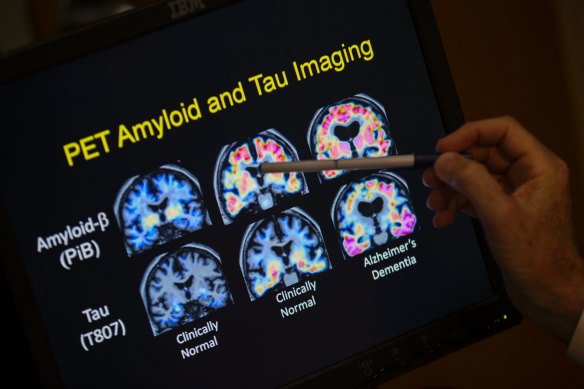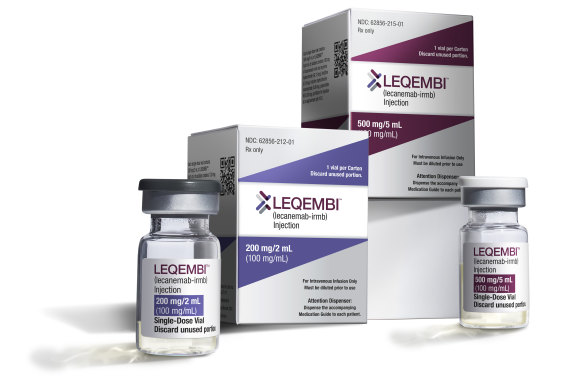This was published 9 months ago
First new Alzheimer’s drugs in 20 years to bring hope for early-stage patients
By Wendy Tuohy
Two new Alzheimer’s drugs aimed at slowing cognitive delay and heralded as a step towards prevention are expected to be given the green light for Australian patients soon.
They are the first drugs to get approval internationally for treatment of the life-limiting illness in more than 20 years, but local experts are warning that the medications are expensive, need monitoring and may be available to only about 15 per cent of those living with Alzheimer’s.
Demand for the drugs has been predicted to be overwhelming, and the federal government has been urged to establish a taskforce to prepare to deliver them.

The first new drugs in more than 20 years for the treatment of Alzheimer’s disease are likely to be available here soon.Credit: AP
In an 18-month trial involving 1795 people aged 50 to 90, the first of the drugs, lecanemab, showed a 27 per cent reduction in cognitive decline for those on it compared with those on a placebo. Patients gained six months of cognitive stabilisation.
The drug’s approval was accelerated by the US Food and Drug Administration, and it is in use among patients with early-stage Alzheimer’s disease, the only stage at which patients are eligible.
Lecanemab was evaluated by the Australian Therapeutic Goods Administration on June 6, and is expected to be available here later this year, but it will cost about $38,000 a year per person. It will be considered by the Pharmaceutical Benefits Advisory Committee on July 24, and the decision released on August 23.
The drug (brand name Leqembi) and its newer relative, donanemab, “significantly slow the worsening of thinking and memory problems for Australians with mild Alzheimer’s”, said Professor Christopher Rowe, director of the Australian Dementia Network.
When combined with early detection blood tests that are also coming, the drugs may be a step towards prevention because they could remove the plaques believed to cause Alzheimer’s before they do damage, he said.
“They’re a great first step, and this is exciting,” said Rowe, who is also head of molecular imaging research at Austin Health.
“But like the first drugs used for treating any disease, they’re not perfect. These drugs do carry a risk of serious side effects that require careful monitoring with repeated MRI scans over the first six months.”
Potential serious side effects include swelling of the brain, or bleeding on the surface of the brain, for which regular scans will check.

Leqembi has been given full FDA approval to treat Alzheimer’s in the US and is expected to be approved soon in Australia.Credit: AP
Leqembi is delivered by twice-monthly infusions and is already being used in the United States, China, Japan and South Korea, and in several clinical trials in Australia.
On June 10, an advisory panel to the US Food and Drug Administration voted to endorse the latest in its class, donanemab.
On Thursday, manufacturer Eli Lilly informed the Alzheimer’s Association International Conference that donanemab slowed the progression of Alzheimer’s by 60 per cent for early-stage patients. Results were weaker for older patients whose disease was more advanced.
Both new drugs work by removing a protein known as amyloid from the brain. Amyloid forms plaques on the brains of people with Alzheimer’s disease.
“The accumulation of amyloid can be detected 15 years before the disease becomes evident,” Rowe said, and many people with no cognitive symptoms have it. His network did PET scans of 550 healthy Australians for potential inclusion in a local trial and found 100 had amyloid levels suitable for inclusion.
“That’s how common this condition is in over-60s. If you get into the 80s, more than 50 per cent of people have a positive amyloid scan and if they live long enough, they will start developing symptoms,” he said.
More than 487,000 Australians live with dementia and Alzheimer’s disease, and dementia is the second-leading cause of death in Australia – the leading cause of death for women.
About 40,000 people would be eligible for Leqembi now, Rowe said. To be eligible, patients must be diagnosed with mild cognitive impairment or mild dementia, and have a PET scan or lumbar puncture to show plaques are present, and an MRI to look for other brain diseases.
Professor Ralph Martins, director of research at Alzheimer’s Research Australia, said lecanemab and donanemab were “disease modifying drugs”, whereas until recently, drugs used for Alzheimer’s disease worked only to treat symptoms.
“It really slows the condition down; people can be more functional for a lot longer and need less help with care, which means a lot to them and their families,” Martins said.
‘It really slows the condition down; people can be more functional for a lot longer and need less help with care.’
Professor Ralph Martins, Alzheimer’s Research Australia
“We expect donanemab to be released in Australia by the end of this year. They are not the complete answer yet, but they have a profound effect on slowing disease quite significantly compared to other [drugs], and the exciting news is these drugs are getting better and better,” he said.
The earlier a person started on the drugs, the more benefit they were likely to deliver, he said, which made it important to speak to GPs as soon as cognitive difficulties appeared.
Demand for the drugs exists, but Australian health infrastructure was not ready to deliver them and a national taskforce was needed to prepare, said neurologist Professor Amy Brodtmann, head of the Cognitive Health Initiative in the Department of Neuroscience at Monash University.
Brodtmann was a co-author of a Medical Journal of Australia paper that argued the system does not yet have capacity to provide disease-modifying therapies for Alzheimer’s disease.
“We do not feel Australia is ready at present. We need to provide diagnostic expertise, resources, and monitoring capacity for our patients. However, with some modifications and additions, we could be,” the expert authors stated.
Brodtmann said there was cautious optimism about the the drugs, but clinics, staff and funding were necessary to triage patients and deliver treatment. Also, questions remain about how the drugs would be funded for use in the public system.
Dr Kate Gregorevic, a gerontologist and author of the book Before Dementia, said the new drugs removed amyloid well but had limitations.
“While the new medications which have been approved in the USA are very successful at removing amyloid, this slows, not stops, the progression of cognitive decline,” she said.

Dr Kate Gregorevic says the costs and benefits of the new Alzheimer’s drugs must be weighed, given the limited clinical impact shown so far.Credit: Jason South
“The effect size was statistically significant, but clinically very small. There are also risks from these medications, with around a quarter of people developing brain swelling and one in five [experienced] micro-haemorrhages.”
Cost-benefit for the community should also be considered, as the drugs are expensive and require significant new investment in monitoring capability, through scanning.
Start the day with a summary of the day’s most important and interesting stories, analysis and insights. Sign up for our Morning Edition newsletter.